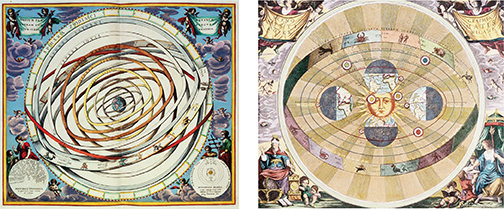Geocentric Model
Most ancient Greeks thought that Earth was at the center of the universe. They believed that all the stars and planets lay on the inside of a giant sphere that revolved around Earth once a day. Since geo is the Greek word for “Earth,” such a model is called a geocentric (jee oh SEN trik) model.  In a geocentric model, Earth is stationary while objects in the sky move around it. The original geocentric model was modified about A.D. 140 by the Egyptian astronomer Ptolemy (TAHL uh mee) to more accurately predict positions of the planets. Ptolemy's geocentric model was widely accepted for nearly 1400 years.
In a geocentric model, Earth is stationary while objects in the sky move around it. The original geocentric model was modified about A.D. 140 by the Egyptian astronomer Ptolemy (TAHL uh mee) to more accurately predict positions of the planets. Ptolemy's geocentric model was widely accepted for nearly 1400 years.
Heliocentric Model
Even in ancient times, not everyone thought that Earth was at the center of the universe. The Greek astronomer Aristarchus developed a heliocentric (hee lee oh SEN trik) model.  In a heliocentric model, Earth and the other planets revolve around the sun. Figure 2 illustrates the geocentric and heliocentric models. Although today we know that Aristarchus was correct, his model was not accepted by most ancient Greeks. The geocentric model could explain all observations made at that time. Moreover, Earth's motions are not obvious to observers on Earth.
In a heliocentric model, Earth and the other planets revolve around the sun. Figure 2 illustrates the geocentric and heliocentric models. Although today we know that Aristarchus was correct, his model was not accepted by most ancient Greeks. The geocentric model could explain all observations made at that time. Moreover, Earth's motions are not obvious to observers on Earth.
In the early 1500s, the heliocentric model was revived by the Polish scientist Nicolaus Copernicus. Copernicus realized that the motion of the planets could be more simply expained if they are revolving around the sun rather than around the Earth. The observations of Italian scientist Galileo Galilei and other scientists later proved that the heliocentric model was correct.
The apparent motions of the sun, moon, and stars result from Earth's daily rotation on its axis. As Earth rotates, it seems that we are stationary and all of the objects in the sky are spinning around us. The northern stars appear to circle around the North Star because Earth's axis points toward a spot in the sky close to that star.
Figure 2 Andreas Cellarius drew these maps of the geocentric model (left) and heliocentric model (right) in the 1660s. Comparing and Contrasting Where does Earth appear in each diagram?






